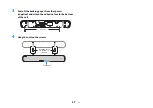
l
Sound from an HDMI control-enabled TV is set for output from
the TV’s built-in speakers.
Use the TV’s HDMI settings to set audio output to any option other
than the TV’s built-in speakers.
No sound is coming from the subwoofer
l
The playback source does not contain low-frequency signals.
Play back a sound source containing low-frequency signals, and
confirm that the sound is output from the subwoofer.
l
The volume is too low.
Turn up the volume of the subwoofer. For details, see the following:
– “Basic procedure for playback” (p.22)
The volume decreases when the unit is
turned on
l
The automatic volume adjustment function is activated.
To prevent excessive loudness, the unit automatically controls its
volume within a certain level when the unit is turned on. Turn up the
volume as required. For details, see the following:
– “Basic procedure for playback” (p.22)
No surround effect
l
Stereo playback is selected.
Select surround playback or 3D surround playback. For details, see
the following:
– “Playback with 3D surround sound/surround sound” (p.27)
l
The volume is too low.
Turn up the volume. For details, see the following:
– “Basic procedure for playback” (p.22)
l
The TV or AV device is set to output 2-channel audio (such as
PCM) only.
Change the digital audio output setting on the TV or AV device to
multi-channel linear PCM or bitstream.
l
Sound is also heard from the TV built-in speakers.
Set the TV volume to minimum.
l
The listening position is too close to the unit.
The listening position should be at some distance from the unit.
Noise is heard
l
The unit is too close to another digital or high-frequency device.
Move those devices away from the unit.
En
48











































